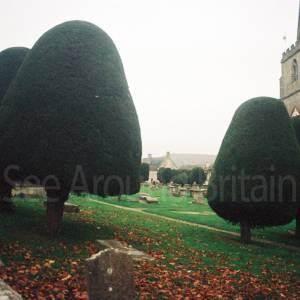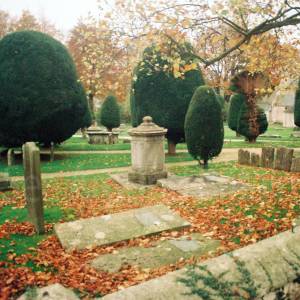St Mary's Church, Painswick
Details
Accessibility
https://www.achurchnearyou.com/church/14059/facilities/
"The Church Building at St Mary’s has level access, and is fine for wheelchairs."
Brief description
"The Church of England parish church of Saint Mary is a Grade I listed building. A priest in Painswick is noted in the Domesday Book and so it is assumed that there was also a church here at that time. Evidence suggests that it was built between 1042 and 1066 by Ernesi, a rich Anglo Saxon thegn who was then Lord of the Manor.
After the Norman conquest the Lordship passed to the family of de Laci, the patron saint of whom was Saint Peter. In 1377 the chapel at the north side of the church was rebuilt and dedicated to St Peter. This is the oldest part of the church. Shortly afterwards the north aisle was added. By this time the de Laci family had given the living to the Prior and Canons of Llanthony Priory, who had spiritual oversight of the parish until the Reformation.
The nave and tower were built about 1480, and by 1550 the sanctuary had taken its present form. The spire was not added until 1632. The church remained in this form until the English Civil War when it was occupied by Parliamentarians in 1644. The Royalists recaptured the village, however, after severe fighting. Bullet and cannon shot marks remain on the church tower to this day. The church was greatly damaged by fire.
In 1657 a gallery was added to the north aisle. In 1740 the south aisle was built with a gallery above. A west gallery was added in 1840. In 1877 the church was restored by public subscription. The font dates from 1661 and replaced one destroyed during the civil war. The Royal arms over the entrance door are those of William IV.
The imposing tomb was occupied by three different families and suffered in the fire of 1644. The First World War screen was carved by a Belgian refugee and lists all those from Painswick who served, with the names of those who died in gold.
The organ was originally built in the 18th century by Sneltzer but only the casing remains. The present instrument was installed by Nicholson of Worcester.
A bell ringers' society was formed in 1686 and the ringers are still known as the "Ancient Society of Painswick Youths". Before 1731 there were eight bells, but the ring was augmented in 1732 and in 1819 by four further bells. In 1986, to celebrate the tercentenary of the society, a thirteenth bell was added and the clock face restored. In 1993 the addition of an extra treble bell, made possible by a generous donation, completed the present ring of fourteen bells.
The St Mary's Parish churchyard is notable for its ancient and numerous yew trees and the Pyramidal tomb of the stonemason John Bryan.
In the churchyard Painswick has a fine collection of chest tombs and monuments from the early 17th century onwards, carved in local stone by local craftsmen. The oldest tomb, with fossils on the top, is of William Loveday, yeoman, dated 1623. Alec Clifton-Taylor, an English architectural historian, describes the churchyard, with its tombs and yews, as "the grandest churchyard in England"."
Address
St Mary‘s Parish Church , New Street, Painswick, Gloucestershire, GL6 6UT
https://www.stmaryspainswick.org.uk/contact/
Phone
Get in touch: Lydia Savage, Administrator, The Beacon Benefice,
Benefice Office, The Lychgate, Stroud Road, Painswick, Gloucestershire
(01452) 814795
Website
https://www.stmaryspainswick.org.uk/
https://www.achurchnearyou.com/church/14059/
https://en.wikipedia.org/wiki/Painswick
https://historicengland.org.uk/listing/the-list/list-entry/1000777
Directions
"Painswick is 3 miles North of Stroud, on the A 46. There is a public car park (pay and display) less than 200 metres from the church building. In is a footpath through an archway giving access from the Car Park directly to the churchyard. The Church Building at St Mary’s has level access, and is fine for wheelchairs. Inside the Church Building you will find guides to the church on sale, or for use during your visit. Many people find that a visit to St Mary’s and its churchyard is a good way to start their visit to the village. There is a Tourist Information Centre on weekdays in the Gravedigger’s Hut, which is the small building on the left as you enter the Churchyard from the Car Park.
By Car : Painswick is on the A46 road between Cheltenham and Stroud – about 3 miles north of Stroud. Car parking in the narrow streets of Painswick is often problematical. It is suggested that you should try and park in the Stamages Lane Car Park at the south end of the village (charges 20 p per hour at time of writing, 2021). For “satnav” enthusiasts the post code GL6 6UZ will find the car park."
Opening Times
Always check with the venue directly for up-to-date information including opening times and admission charges as they may be subject to change
https://www.stmaryspainswick.org.uk/im-new-here/
2021: "St. Mary’s Church, Painswick is open to visitors every day of the year. Opening times are 9.30 am (at latest) to 4 pm from October to March (inclusive) and 9.30 am to 6 pm from April to September."
Transport
"Bus: The No 46 bus from Cheltenham to Stroud stops in Painswick at one of the entrances to the churchyard. There is an hourly service on this route during the day."
For further travel information please see: www.traveline.info
Or call Traveline on 0871 200 22 33
(Calls cost 12p per minute plus your phone company's access charge)
Amenities
https://www.achurchnearyou.com/church/14059/facilities/
Travel Information
For further travel information please see: www.traveline.info
Or call Traveline on 0871 200 22 33
(Calls cost 12p per minute plus your phone company's access charge)











